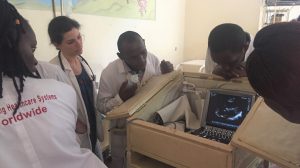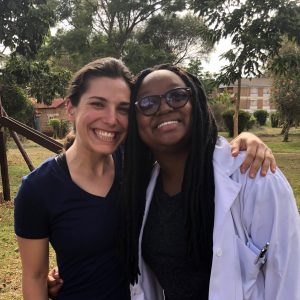Relying on Training During Medical Crisis in Rural Kenya
by Miriam Weiss
“1 and 2 and 3” “Breath” “1 and 2 and 3” “Breath”. The resident and I were speaking aloud as we manually ventilated a 6 month old boy in respiratory failure. I was hoping for the feeling of spontaneous breath as you’re ventilating a child, a feeling I had only first experienced three weeks prior. This was an example of a patient experience during the international educational rotation at the PCEA hospital in Chogoria, Kenya I completed. The American resident and I were ventilating the 6 month old boy as the family of the child and consulting physicians were discussing options for moving forward. The options included: One, Continue to ventilate the young child with bag and mask in hopes his respiratory status may improve. Option two was to attempt to transfer the child to an ICU at a different hospital where he could be intubated and placed on a mechanical ventilator for respiratory support. The nearest hospital was contacted, and was four hours away. Due to lack of proper resuscitation medications they were not willing to accept a patient to the ICU. This option brought on a feeling of anxiety for our team, remembering the 2 year old girl from three weeks prior who had been transferred after she was resuscitated only to have a fatal outcome in the emergency department of the accepting hospital. There was a miscommunication about bed availability. Option three was to put the child in the ICU at PCEA hospital. This hospital did not have the proper supplies for intubating an infant, and no provider has the skills to manage a child on a mechanical ventilator. The fourth option was to discontinue ventilation assistance, supply oxygen through nasal cannula and allow the six month old child to fight on his own. The child had been resuscitated earlier that day due to respiratory arrest and had a poor neurological prognosis.
Spending a rotation at a hospital in Chogoria, Kenya forced me to participate in complex medical and ethical decision making in a resource limited setting. Life and death decisions-like the one described. I was forced to think through possible diagnoses and treatments with the limited information available. I found us diverging from the algorithms that become routine when resources are essentially unlimited. We were forced to use the knowledge and skills learned through our training to best care for each patient using what was available diagnostically and for treatment.
The curriculum goals of this international elective included: 1. Provide exposure to diseases not generally encountered during US medical training 2. Develop medical skills with less reliance on modern technology 3. Provide a cross-cultural medical experience beyond what is possible in the US 4. Allow residents to develop and nourish their sense of altruism 5. Expose physicians, early in their career to the possibilities of working in the developing world and/or underserved populations 6. Understand the interaction between health, social, cultural, and environmental issues.
 In Kenya I was immersed in a resource limited setting, in a new culture and was able to understand strategies for allocating resources and treating patients. The educational experience I was privileged to participate in was unparalleled. I participated in discussions regarding diagnostics and patient care. I improved my physical exam skills, and used findings to drive treatment plans. Not only did I improve my skills related to my goals, I learned a new level of empathy, understanding and thinking that will no doubt provide a basis for my practice as a young physician.
In Kenya I was immersed in a resource limited setting, in a new culture and was able to understand strategies for allocating resources and treating patients. The educational experience I was privileged to participate in was unparalleled. I participated in discussions regarding diagnostics and patient care. I improved my physical exam skills, and used findings to drive treatment plans. Not only did I improve my skills related to my goals, I learned a new level of empathy, understanding and thinking that will no doubt provide a basis for my practice as a young physician.
I learned from the Medical Officer Interns, first year practicing physicians, not just in the medical setting, but also in a cultural setting. I became more aware of working with patients of a different race and different culture. I now know what it feels like to be the only person of a particular race in a room filled with hundreds of people who look different. I was not only involved in active learning throughout my experience, I became a teacher in medicine. I presented a lecture on pediatric hip pathologies during the morning lecture series at the hospital. I spent time reading information on disease processes. Some that I was more familiar with, and some, such as TB and Brucellosis, that I was seeing for the first time. I discussed treatment plans and patient information with my new colleagues and friends. I was able to help relieve some of the stress and workload of the interns by picking up my own patients, writing progress notes, and pre rounding on patients.
I enjoyed the beauty of the Kenyan culture by walking through the market each evening, and eating the most delicious mangos. I listened to popular music while discussing differences in our hairstyles. I was able to recognize the similarities between our lives as medical professionals, and often, while we were laughing together, I would almost forget how different our lives are, and the differences in the way we are able to practice medicine based on the resources available. I was reminded of this difference as I was ventilating the 6 month old baby. As a team we recognized the fourth option as being the only feasible option. The difference was evident as we were forced to make a decision to discontinue manual ventilation. This scenario could have been different in another setting. Through this experience I was able to develop the skills to think through and compile enough information to make these difficult decisions.
Medical school has not always been an easy path. I have more than once questioned whether it was the right one for me. This experience solidified my confidence in choosing a career that allows me the privilege to care for others. The educational, medical, ethical and cultural components of this experience will continue to guide me as a physician throughout my career.




